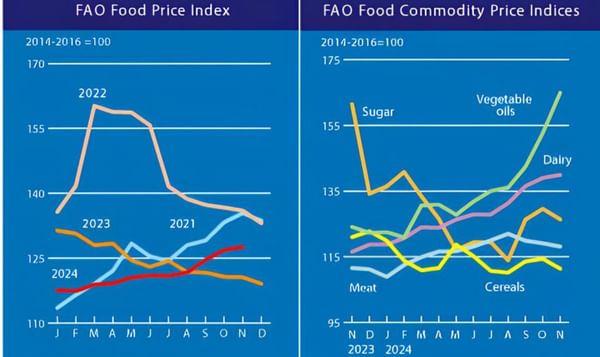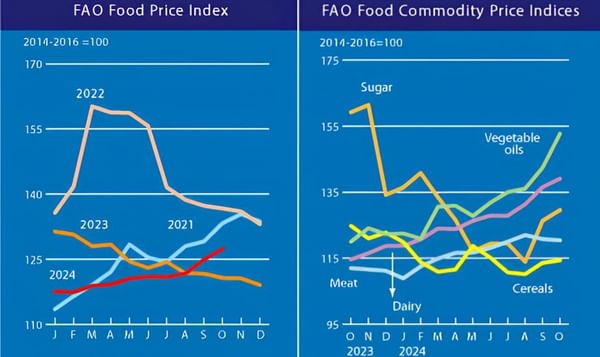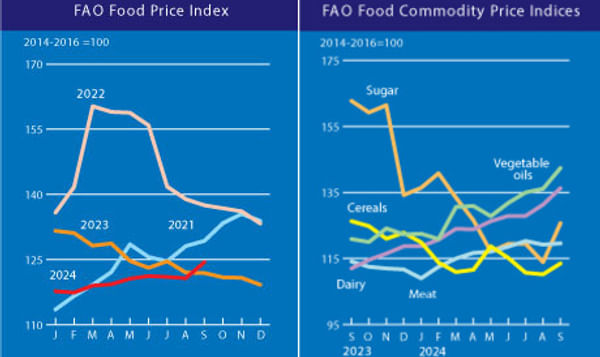The FAO Food Price Index averaged 196.6 points in August 2014, its lowest level since September 2010. In August, the index registered its fifth consecutive monthly decline, down 7.3 points (3.6 percent) from July and 7.9 points (3.9 percent) from August 2013. Except for meat, all the other food sub-indices dipped markedly in August, with dairy values falling most, followed by oils and sugar.
The FAO Cereal Price Index averaged 182.5 points in August, down 2.8 points (1.5 percent) from July and 24.2 points (11.7 percent) from August 2013. The Index has been falling continuously since May, largely on excellent crop prospects and abundant supplies of wheat and coarse grains. Another record world production this year weighs on international wheat prices which slid in August to their lowest value since July 2010. Similarly, maize prices have fallen to a 4-year low, amid almost ideal growing conditions while stocks are already at very high level. However, rice prices remained on the rise reflecting the return of several traditional importers to the market and the failure by Thailand to offload large volumes from public stocks starting in August, as originally announced.
The FAO Vegetable Oil Price Index averaged 166.6 points in August, 14.5 points (8 percent) less than the previous month and the lowest level since November 2009. It would also be the fifth month of consecutive drops in the index. Much of the August decline reflects the pattern of palm oil prices, which have weakened under the combined effect of improved production prospects in South East Asia and lower than anticipated import demand, primarily from China and India. The other major oils (soy, rape and sunflower) also remained on a downward trend, reflecting prospective ample supplies in 2014/15.
The FAO Dairy Price Index averaged 200.8 points in August, down 25.3 points (11.2 percent) over July and 46.8 points (18.9 percent) less year-on-year. Quotations for all dairy products covered in the Index fell. The decline reflected both abundant export availability and reduced import demand. Export supplies have increased in the EU and conditions are favourable for a strong start to the new season in Oceania. The prevailing tendency for prices to decline was further exacerbated by the Russian Federation prohibition, at the beginning of the month, on imports of dairy products from several countries. More generally, slackening importation of whole milk powder by China (the largest importer) has also contributed to market uncertainty concerning demand over the coming months.
The FAO Meat Price Index averaged 207.3 points in August, 2.5 points (1.2 percent) more than its revised value for July and 25 points (14 percent) above last year. The increase principally reflected a strong rise of bovine meat prices in Australia, where herd rebuilding has reduced export supplies, and continued strong import demand in Asia, particularly China. Average quotations for poultry were little changed, while those for porcine and ovine meat fell back somewhat.
The FAO Sugar Price Index averaged 244.3 points in August, down by 14.8 points (5.7 percent) from July, but still 2.2 points (1 percent) higher than in August 2013. The significant drop in prices was triggered by improved production prospects in India, the world’s second largest sugar producer, as well as the European Union and the Russian Federation. In addition, reports of lower than expected import demand by China weighed negatively on international prices. The downgrading of production in Brazil, the world largest sugar producer, was not sufficient to offset the downward price pressure.
The FAO Food Price Index falls to its lowest level since September 2010

Like to receive news like this by email? Join and Subscribe!
Join Our Telegram Channel for regular updates!
Highlighted Company
Sponsored Content
Sponsored Content
Sponsored Content
Sponsored Content
Sponsored Content












